Home > Drawing Directory Home> Drawing Nature > Drawing in Relative Tones and Values
DRAWING AND SKETCHING in relative tones and values
|
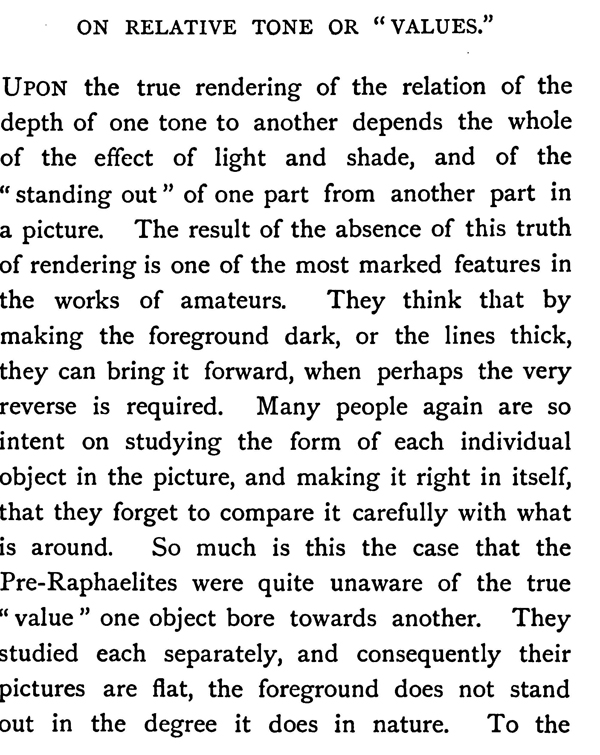
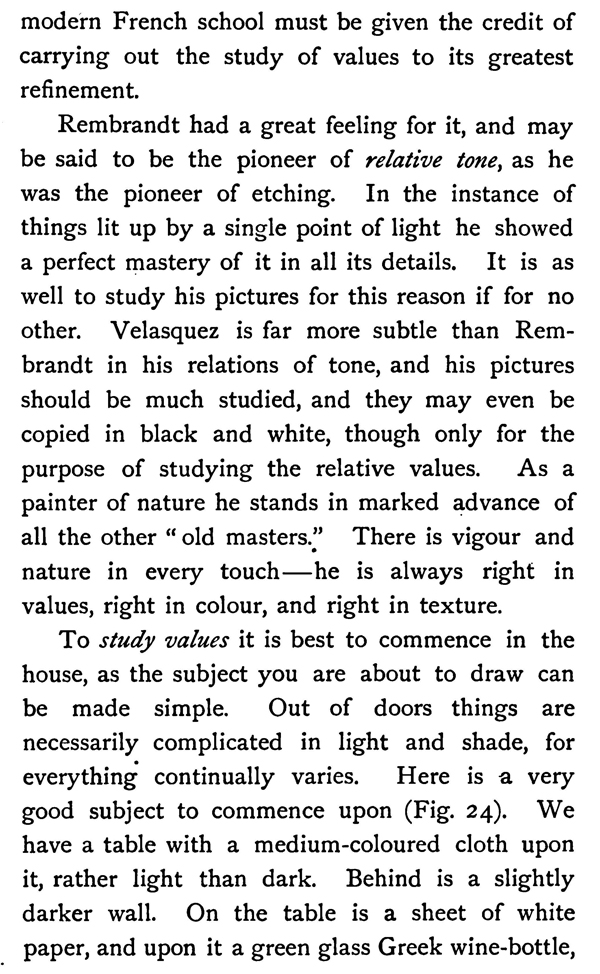
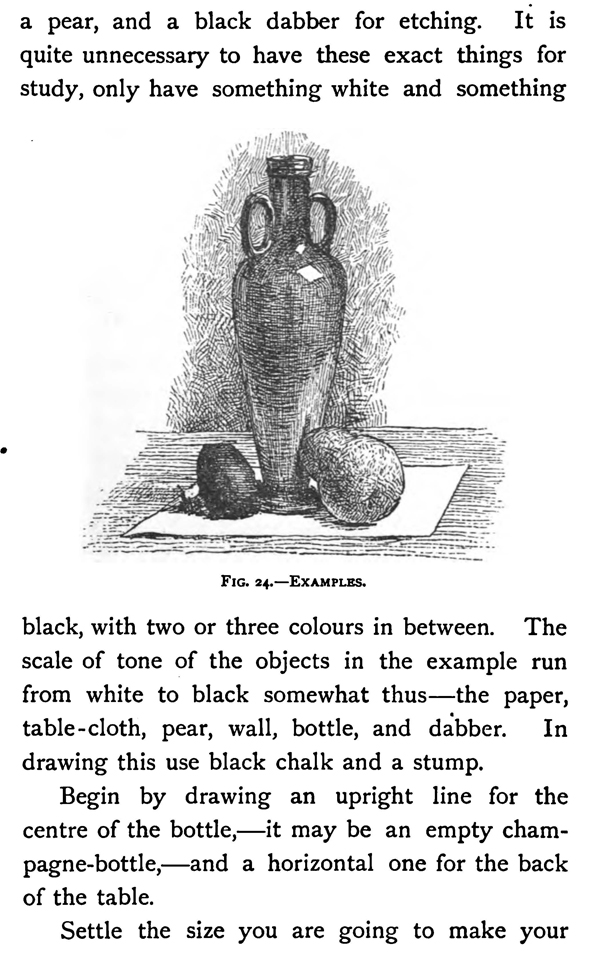
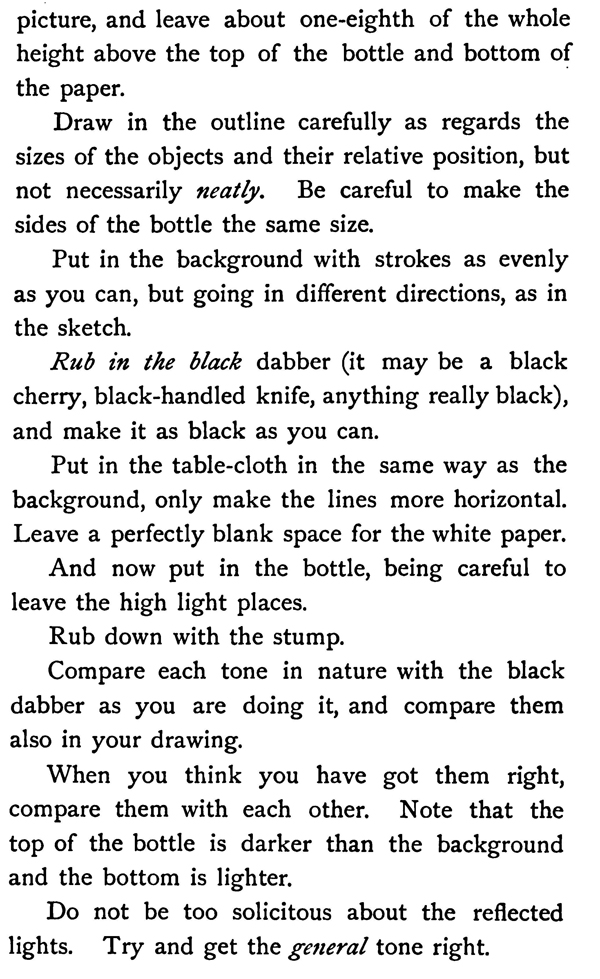
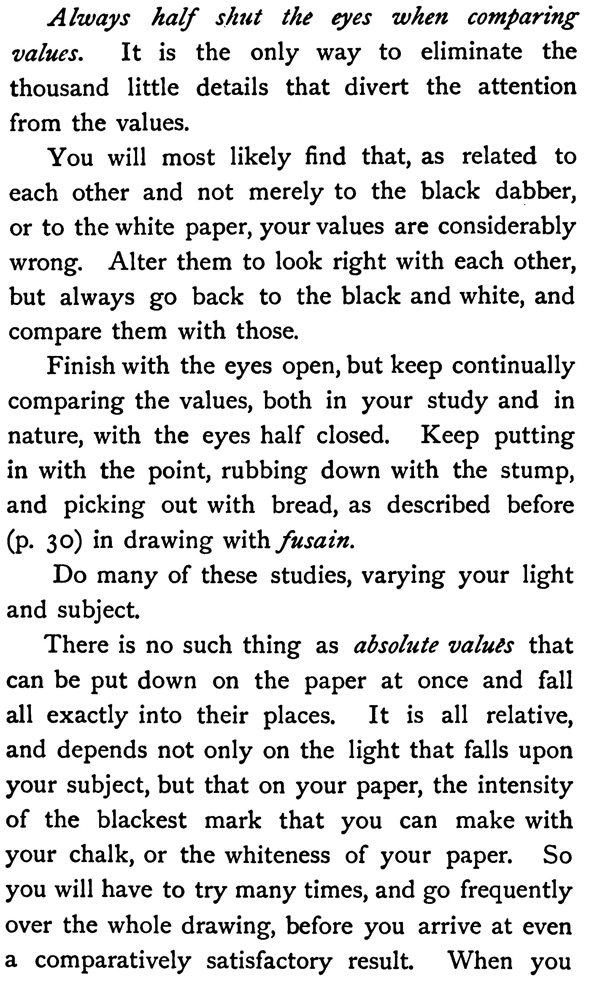
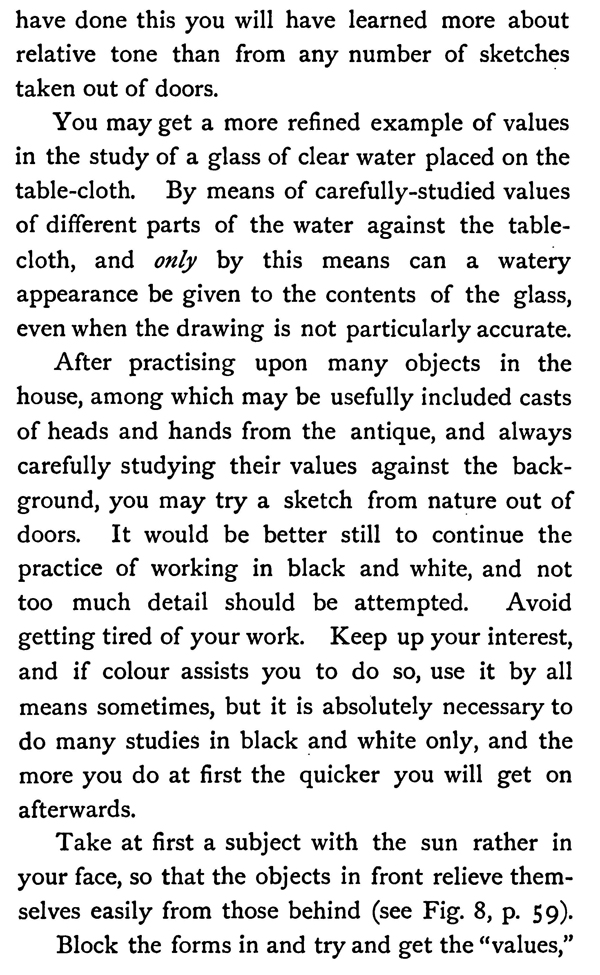

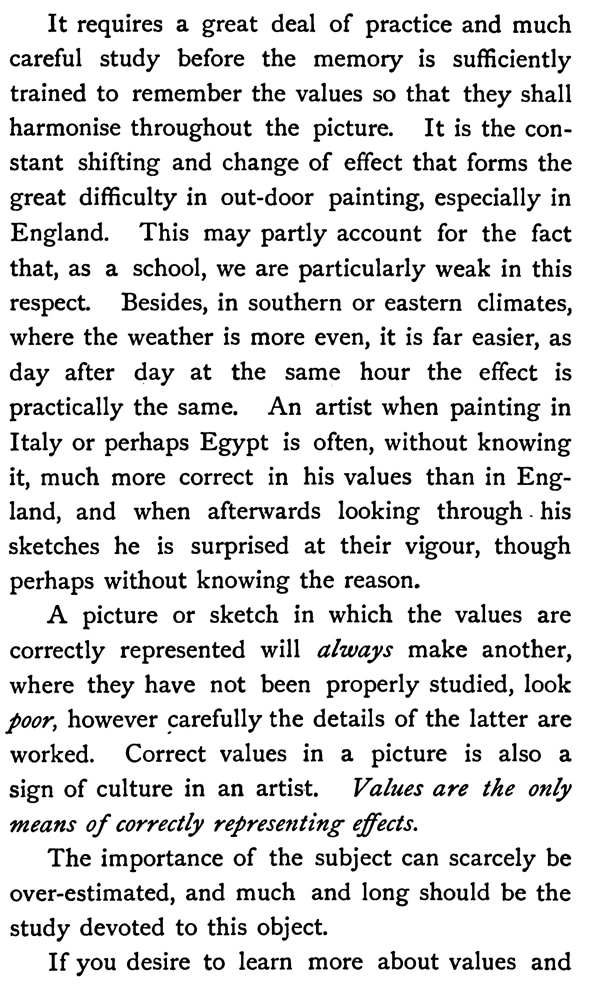
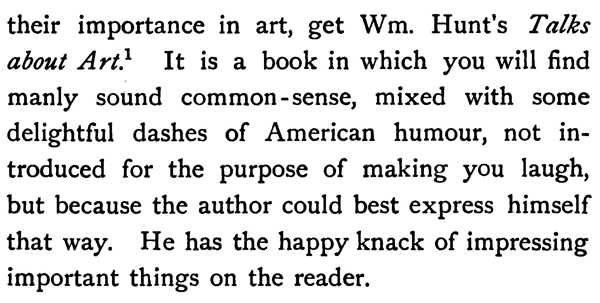
GO BACK TO THE HOME PAGE FOR TUTORIALS FOR BEGINNING ARTISTS
[The above words are pictures of text, below is the actual text if you need to copy a paragraph or two]
ON RELATIVE TONE OR " VALUES."
UPON the true rendering of the relation of the depth of one tone to another depends the whole of the effect of light and shade, and of the " standing out " of one part from another part in a picture. The result of the absence of this truth of rendering is one of the most marked features in the works of amateurs. They think that by making the foreground dark, or the lines thick, they can bring it forward, when perhaps the very reverse is required. Many people again are so intent on studying the form of each individual object in the picture, and making it right in itself, that they forget to compare it carefully with what is around. So much is this the case that the Pre-Raphaelites were quite unaware of the true " value " one object bore towards another. They studied each separately, and consequently their pictures are flat, the foreground does not stand out in the degree it does in nature. To the modern French school must be given the credit of carrying out the study of values to its greatest refinement.
Rembrandt had a great feeling for it, and may be said to be the pioneer of relative tone, as he was the pioneer of etching. In the instance of things lit up by a single point of light he showed a perfect mastery of it in all its details. It is as well to study his pictures for this reason if for no other. Velasquez is far more subtle than Rembrandt in his relations of tone, and his pictures should be much studied, and they may even be copied in black and white, though only for the purpose of studying the relative values. As a painter of nature he stands in marked advance of all the other " old masters:: There is vigour and nature in every touch—he is always right in values, right in colour, and right in texture.
To study values it is best to commence in the house, as the subject you are about to draw can be made simple. Out of doors things are necessarily complicated in light and shade, for everything continually varies. Here is a very good subject to commence upon (Fig. 24). We have a table with a medium-coloured cloth upon it, rather light than dark. Behind is a slightly darker wall. On the table is a sheet of white paper, and upon it a green glass Greek wine-bottle, a pear, and a black dabber for etching. It is quite unnecessary to have these exact things for study, only have something white and something black, with two or three colours in between. The scale of tone of the objects in the example run from white to black somewhat thus—the paper, table-cloth, pear, wall, bottle, and dabber. In drawing this use black chalk and a stump.
Begin by drawing an upright line for the centre of the bottle,—it may be an empty champagne-bottle,—and a horizontal one for the back of the table.
Settle the size you are going to make your picture, and leave about one-eighth of the whole height above the top of the bottle and bottom of the paper.
Draw in the outline carefully as regards the sizes of the objects and their relative position, but not necessarily neatly. Be careful to make the sides of the bottle the same size.
Put in the background with strokes as evenly as you can, but going in different directions, as in the sketch.
Rub in the black dabber (it may be a black cherry, black-handled knife, anything really black), and make it as black as you can.
Put in the table-cloth in the same way as the background, only make the lines more horizontal. Leave a perfectly blank space for the white paper.
And now put in the bottle, being careful to leave the high light places.
Rub down with the stump.
Compare each tone in nature with the black dabber as you are doing it, and compare them also in your drawing.
When you think you've got them right, compare them with each other. Note that the top of the bottle is darker than the background and the bottom is lighter.
Do not be too solicitous about the reflected lights. Try and get the general tone right.
Always half shut the eyes when comparing values. It is the only way to eliminate the thousand little details that divert the attention from the values.
You will most likely find that, as related to each other and not merely to the black dabber, or to the white paper, your values are considerably wrong. Alter them to look right with each other, but always go back to the black and white, and compare them with those.
Finish with the eyes open, but keep continually comparing the values, both in your study and in nature, with the eyes half closed. Keep putting in with the point, rubbing down with the stump, and picking out with bread, as described before (p. 30) in drawing with fusain.
Do many of these studies, varying your light and subject.
There is no such thing as absolute values that can be put down on the paper at once and fall all exactly into their places. It is all relative, and depends not only on the light that falls upon your subject, but that on your paper, the intensity of the blackest mark that you can make with your chalk, or the whiteness of your paper. So you will have to try many times, and go frequently over the whole drawing, before you arrive at even a comparatively satisfactory result. When you have done this you will have learned more about relative tone than from any number of sketches taken out of doors.
You may get a more refined example of values in the study of a glass of clear water placed on the table-cloth. By means of carefully-studied values of different parts of the water against the tablecloth, and only by this means can a watery appearance be given to the contents of the glass, even when the drawing is not particularly accurate.
After practising upon many objects in the house, among which may be usefully included casts of heads and hands from the antique, and always carefully studying their values against the background, you may try a sketch from nature out of doors. It would be better still to continue the practice of working in black and white, and not too much detail should be attempted. Avoid getting tired of your work. Keep up your interest, and if colour assists you to do so, use it by all means sometimes, but it is absolutely necessary to do many studies in black and white only, and the more you do at first the quicker you will get on afterwards.
Take at first a subject with the sun rather in your face, so that the objects in front relieve themselves easily from thosebehind (see Fig. 8).
Block the forms in and try and get the "values," as seen with the eyes half closed, as quickly as possible, before they have time to change. The time taken ought scarcely ever to be more than half-an-hour.
After acquiring sufficient skill with charcoal, oil colours may be used. The colour will be an additional difficulty, but you should attend less to it at first than to the " values." Make small sketches, about six inches by four, as quickly as you can, without attempting any detail, but carefully noting the values and colours. These are called " impressions," and should be made in great numbers by all landscape artists. It is only thus they can get a true appreciation of natural colour and tone. Their work, after a course of them, will acquire a solidity and strength that it had no trace of before.
Effects with the sun behind the artist are the most difficult, and should only be attempted after considerable skill is obtained in doing sketches full of shadow. Everything depends upon such slight gradation of tone, mixed with a strong shadow here and there, that unless the tones are most carefully studied it would look harsh and unnatural. When there is no sun the values are much more delicate than when there is, and although they seem always the same, yet they are constantly varying from hour to hour.
It requires a great deal of practice and much careful study before the memory is sufficiently trained to remember the values so that they shall harmonise throughout the picture. It is the constant shifting and change of effect that forms the great difficulty in out-door painting, especially in England. This may partly account for the fact that, as a school, we are particularly weak in this respect. Besides, in southern or eastern climates, where the weather is more even, it is far easier, as day after day at the same hour the effect is practically the same. An artist when painting in Italy or perhaps Egypt is often, without knowing it, much more correct in his values than in England, and when afterwards looking through his sketches he is surprised at their vigour, though perhaps without knowing the reason.
A picture or sketch in which the values are correctly represented will always make another, where they have not been properly studied, look poor, however carefully the details of the latter are worked. Correct values in a picture is also a sign of culture in an artist. Values are the only means of correctly representing effects.
The importance of the subject can scarcely be over-estimated, and much and long should be the study devoted to this object.
If you desire to learn more about values and their importance in art, get Wm. Hunt's Talks about Art.' It is a book in which you will find manly sound common-sense, mixed with some delightful dashes of American humour, not introduced for the purpose of making you laugh, but because the author could best express himself that way. He has the happy knack of impressing important things on the reader.
Privacy Policy ..... Contact Us




